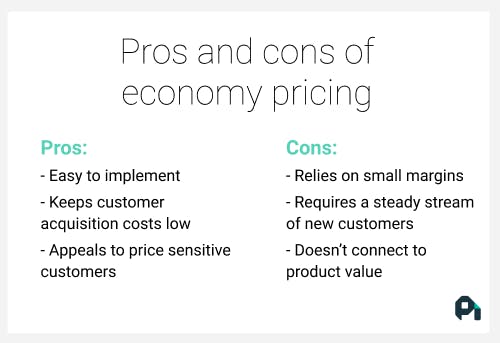Whether you know it or not, you've encountered the economy pricing model. It's why you buy generic cola instead of Coke. Or facial tissues instead of Kleenex.
It’s a pricing strategy employed by businesses to make generic and commodity goods appealing. In other words, it makes customers feel like they’re getting a deal. Store-brand products and generic medications are some of the best examples of economy pricing at work.
In today’s article, we’ll talk through the economy pricing model, how it works, and some popular examples. While it may not seem like the best choice for SaaS and subscription companies at first, understanding where and when the model is valuable helps you craft a more well-rounded pricing strategy for your business.
What is economy pricing?
Economy pricing is a volume-based pricing strategy wherein you price goods low and gain revenue based on the number of customers who purchase your product. It's typically used for commodity goods, like generic-brand groceries or medications, that don't have the marketing and advertising costs of their name-brand counterparts.
How do you execute economy pricing?
At its core, an economy pricing strategy is similar to a cost-plus pricing strategy. You take a product with relatively low production costs and set a price for it that provides you with a small profit.

With such a low price, economy pricing is very much a volume play. The only way you’ll make a profit is if you bring in a large amount of customers on a consistent basis. That makes acquisition incredibly important because you won’t be able to rely on existing customers to drive revenue over time.
Common products that use economy pricing
Economy pricing is used a lot in the commodity goods market. It’s a great strategy for companies that have low overhead costs and the ability to sell a larger number of products to new customers on a regular basis. Here are a few examples of economy pricing in today’s market:
Supermarket store brands
Every grocery store you go into has their own version of popular brands. Companies like Trader Joe’s and ALDI are two examples that capitalize on economy pricing to drive their growth.
Generic drugs and medications
Much like supermarket store brands, there are lots of different types of generic over-the-counter medications available through companies like CVS and Rite-Aid.
Big box stores
Companies like Costco and BJ’s take the economy pricing model to the next level by selling primarily their own brands. While name brands are still available, the major draw of these types of stores is the quality-to-price ratio of their generic brands.
Budget airlines
Many airlines will provide economy pricing to fill seats in their planes, offering much lower prices for the first seats that are purchased and scaling up the price as availability decreases (which incorporates premium pricing as well).
In the SaaS and subscription markets, economy pricing is less prevalent, but there have been examples of subscription ecommerce businesses that thrive with economy pricing.
One economy pricing example that comes to mind is Dollar Shave Club, which used the strategy to draw customers away from established brand names like Gillette. To do so, it needed to factor in the increased marketing and advertising costs that aren’t typical for most economy pricing companies.
Pros and cons of economy pricing
Economy pricing can be a valuable acquisition strategy for SaaS and subscription businesses. But as subscriptions are built on recurring customer relationships, the unit economics of selling at such a low price makes it difficult to build a revenue base over time.

Pros of economy pricing
Economy pricing presents some interesting benefits for larger, more established companies. It’s easy to implement, keeps costs low, and makes your product or service appealing to buyer personas who are particularly interested in “getting a deal.” There tend to be lower customer acquisition costs (CAC) than other pricing strategies, coupled with the fact that you can acquire customers faster.
Being able to enter a market quicker and cheaper can help new entrants find their foothold as well, but the tradeoff is a decrease in pricing power. Economy pricing is more of an acquisition strategy than a pricing one.
Cons of economy pricing
When you’re considering economy pricing, it’s important to understand that it only works in very specific market conditions. Companies that have no market share or brand awareness won’t be able to keep their operational costs low enough to make this pricing model work. And if you’re just starting out, economy pricing can negatively impact the customers’ perception of value for your brand.
The model relies on thin profit margins to keep prices low and requires a consistent volume of new customers to maintain revenue. Pricing your product or service so low makes it hard for potential customers to connect the value of the product with its price and makes it difficult to raise prices or capture expansion revenue in the future.
Do we recommend economy pricing?
For SaaS and subscription companies, economy pricing can present problems if market conditions aren’t exactly correct. Not only do you need to understand the true operational costs to build your product or service, but you also need to keep these costs low, even as your company and customer base grow. These thinner profit margins don’t give you a lot of room for mistakes.
That said, if you’re in a market where buyers are budget-friendly, marketing and advertising are cheap, and there are enough people to sustain the economy pricing model, it can work as an acquisition strategy. At Price Intelligently, we don’t recommend using economy pricing unless you have a clear plan to monetize these new customers after they’ve been acquired.


